New lenses to ship this year for every Pentax lens mount
posted Monday, September 10, 2012 at 8:02 PM EST
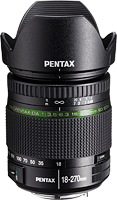
Excited by the new cameras Pentax announced today, and trying to decide what lens to couple them with? Or perhaps you're already a Pentaxian, and you want to add some new glass to your camera bag? Either way, the company has new options for you today, no matter which Pentax mount you're shooting.
Starting with the smallest of the group, the fledgling Pentax Q mount just became rather more viable, with the addition of the PENTAX 06 15-45mm F2.8 Telephoto Zoom lens. It's the sixth lens released so far for the Q mount, but three of those have been what Pentax refers to as Unique-series models, which have some pretty severe limitations due to their lack of an in-lens shutter, variable aperture, or autofocus support. Until now, that's left the Q-mount with just two good lens options, somewhat defeating the purpose of an interchangeable-lens camera. The PENTAX 06 Telephoto Zoom is the third High Performance-series model, and finally provides an option for those looking to go beyond the 83mm-equivalent focal length of the Pentax 02 Standard Zoom. With just two zoom lenses, you can now take the Pentax Q or the new Q10 all the way from a 27.5mm-equivalent wide angle to a 249mm-equivalent telephoto. Interestingly, the lens features Pentax's Quick Shift focus technology, allowing autofocus followed by manual fine-tuning of focus without the need to adjust the focus mode first. The new 06 Telephoto Zoom ships from October, priced at about US$300.
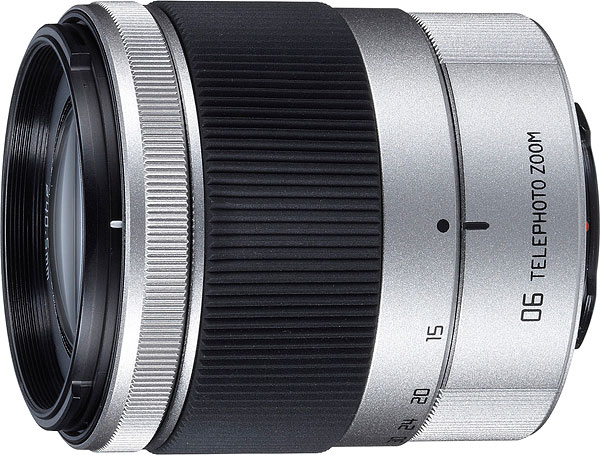
If that's not enough telephoto reach, Pentax is now offering the long-awaited Adapter Q for K-mount lenses, or at least says it will do so by the end of the year. Pricing is set at US$250, and the adapter will let you mount any K-mount lens on the Pentax Q or Q10 body. Like those already offered by some third parties, it's a completely manual design--there's no electrical contacts, no autofocus connectivity, and only a manual aperture control. There is, however, a built-in mechanical shutter mechanism, so you're not reliant on the camera's electronic shutter, which is prone to rolling shutter effect. It'll probably look a somewhat ridiculous pairing with all but the smallest K-mount lenses, but with a focal length crop of approximately 5.5 times, even the standard K-mount 18-55mm kit lens would offer just slightly beyond a 300mm-equivalent telephoto. Mount a 300mm lens on a Q-series camera with the adapter and you'll reach an insane 1,650mm-equivalent telephoto. (Just don't forget your tripod, as no amount of in-body stabilization is going to make that hand-holdable! A separately-available tripod mount will allow you to mount heavier lenses without risk of damage to your Q-series body.)
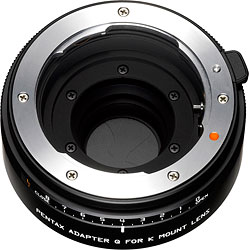
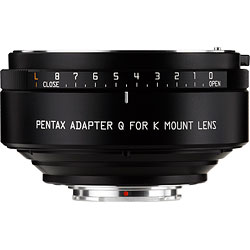
Stepping up to the Pentax K-mount used by the company's digital SLRs, we have two new lens options. One aims at consumers and enthusiasts looking to travel light, while the other is aimed at pros for whom bulk and price aren't too much of a concern. Both lenses are designed for use with APS-C DSLRs only, so if you're still shooting a film body, you likely won't be able to take advantage of them. (And the addition of a new pro lens aimed squarely at APS-C shooters suggests the full-frame crowd may not be seeing a light at the end of the tunnel too soon.)
The smc PENTAX DA 18-270mm F3.5-6.3 ED SDM is the consumer-friendly option, with a focal length range of 27.5mm to 414mm in 35mm equivalents. The 15x zoom range is achieved courtesy of an optical formula with 16 elements in 13 groups, including two extra-low dispersion elements. There's a seven-bladed, rounded aperture diaphragm that should provide attractive bokeh. Maximum aperture varies from f/3.5 at wide angle to f/6.3 at telephoto, and the minimum focusing distance is about 18 inches (45cm). The lens weighs 16 ounces (453 g), measures 3.5 inches in length (8.9 cm), and offers up 62mm filter threads. Since it's an SDM lens, you'll need a camera compatible with these. That includes all recent models, so you'd have to go back quite a few years to find a non-SDM body, but if you have one it will provide manual focusing only. Available from November, this new lens is priced at about US$800.
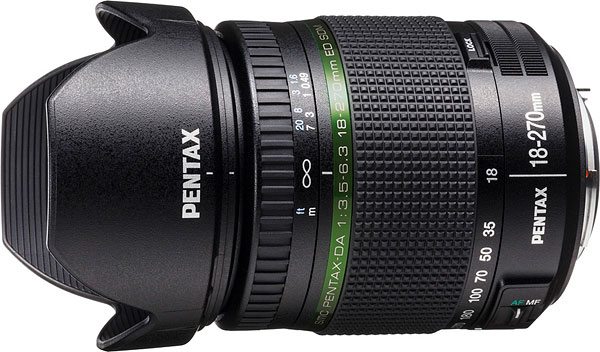
Pentaxian pros will find the K-mount HD PENTAX DA 560mm F5.6 ED and 645-mount HD PENTAX D FA 645 Macro 90mm F2.8 ED AW SR lenses more intriguing.
The HD moniker stands--as you probably guessed--for High Definition, and hints at the presence of a brand-new, multi-layer lens coating. Compared to conventional multi-layer coatings, Pentax claims its HD coating will better control reflections, with a more than 50% reduction over the entire visible spectrum. The company also notes that the HD multicoating allows better control of color balance, and is more durable thanks to higher packing density and a stronger bond between the coating materials. It's said to perform about equally to the nanotech-based Pentax Aero Bright Coating which we've so far seen only on three lenses, the smc PENTAX DA 645 25mm F4 AL (IF) SDM AW, just-announced HD PENTAX D FA 645 MACRO 90mm F2.8 ED AW SR, and DA Star 55mm F1.4 SDM. Not surprisingly, the company doesn't say exactly how the new coating is applied, but it does note that it isn't simply the standard vacuum evaporation method. A Pentax-exclusive process, it says, allows optimum coating density and thickness control with nanometer accuracy.
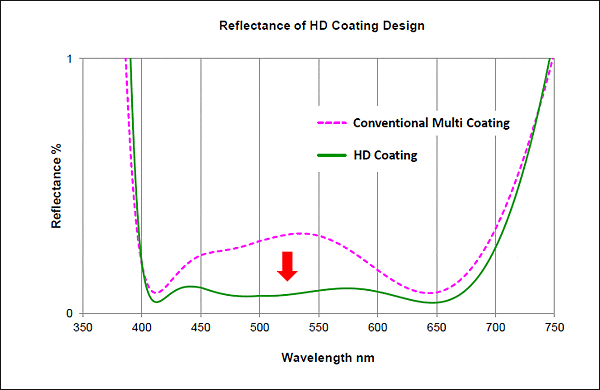
The HD PENTAX DA 560mm F5.6 ED lens is the first K-mount type to feature the HD coating. Priced at US$7,000 and available from December 2012, it takes the K-mount beyond the 300mm mark for the first time since 2004, according to Bojidar Dimitrov's truly encyclopedic Pentax K-mount database. With a 35mm-equivalent focal length of approximately 859mm, and an aperture range of f/5.6 to f/45, the Pentax 560mm has what Pentax calls a telescope-style design with just six elements in five groups, concentrated around the lens' front and rear ends.

The result is a lens that is big, but not as heavy and expensive as you might expect. At a minimum length of 20.5 inches (52.2cm), it's significantly longer than Canon, Nikon, and Sony's 500mm f/4 lenses, Canon and Nikon's 600mm f/4, or even Canon's 800mm f/5.6. It's lighter than all but Canon's 500mm f/4 by an equally significant margin though, at a little over 6.7 pounds (3.04kg)--and even the Canon, it beats by some 5.3 ounces (150g). In fairness, it also isn't as bright as any but the much more powerful Canon 800mm f/5.6. It's also much more affordable in terms of list pricing though. All of the competing lenses come in north of US$10,000 with the exception of the Nikon 500mm f/4 (approx. US$8,600)--and even that lens lists for almost a quarter more than the Pentax.
Other features of the massive, weather-sealed Pentax HD 560mm lens include 112mm filter threads, and a tray for 40.5mm filters in the lens barrel. A bundled circular polarizer installed here can be rotated using a control ring. There's also a nine-bladed rounded aperture, DC autofocus motor with quick-shift mechanism, a built-in extendable lens hood, machined aluminum strap lugs, and a white-painted body designed to reflect heat from sunlight.
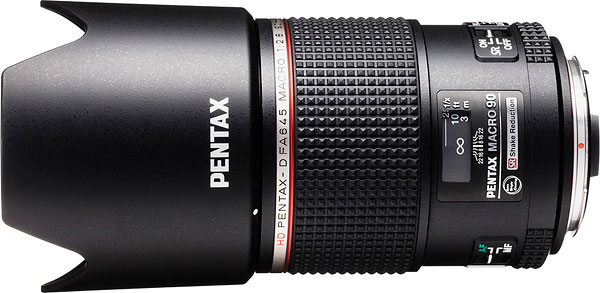
And finally, we come to the 645-mount, where there's a new HD PENTAX D FA 645 Macro 90mm F2.8 ED AW SR lens supporting either digital or film bodies. This again includes the new High Definition coating, but that's where the resemblance to the 560mm lens ends. With a weight of 2.3 pounds, it has the exact same weight as its sibling, the 25mm f/4, but at 4.4 inches in length it's quite a bit shorter. It's the only current 645-mount macro lens, as well, with a minimum focusing distance of 1.4 feet (0.4m) and a magnification of 1:2 (0.5x). The optical formula consists of 11 elements in nine groups, and there's a nine-bladed, rounded aperture diaphragm plus 67mm filter threads. Unusually for a medium-format lens, it's also optically stabilized. And of course, it's weather-sealed, and includes quick-shift autofocus. Priced at US$4,500, this is set to ship from October 2012.
